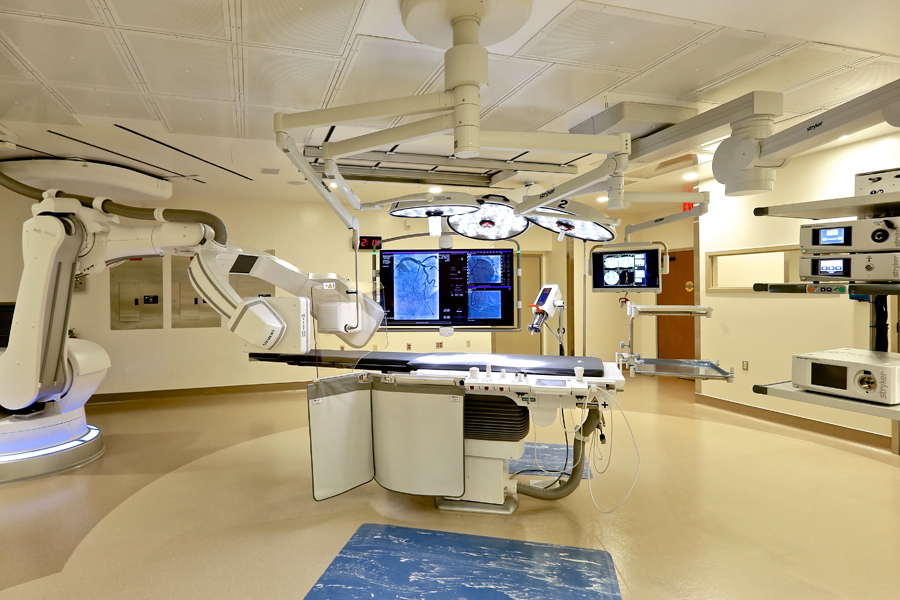Southampton Hospital Debuts Audrey and Martin Gruss Heart & Stroke Center

This week, Southampton Hospital began receiving patients at its two new state-of-the-art operating rooms that make up the Audrey and Martin Gruss Heart & Stroke Center.
One new OR is expected to primarily be used for orthopedic, bariatric and general surgery, while the second OR is a hybrid endovascular surgical suite to treat stroke and vascular disease.
While conventional surgery to treat vascular disease requires seven to 10 days of recovery time, endovascular surgery requires just one or two days. It starts with a catheter in the groin. Surgery is performed inside the blood vessel, without having to open the vessel, which poses much greater risks.
“We knew we needed to create new ORs with endovascular capability,” Southampton Hospital President and CEO Robert Chaloner said during a recent tour of the ORs. Fortunately for the hospital, and the area residents that rely on it, benefactors Audrey and Martin Gruss have an interest in stroke care.
The Grusses gave $5 million in 2012 toward the construction of the center that bears their names. Ground was broken in August 2013.
“Martin and I felt it was important that our local hospital have the capability to conduct stroke and vascular distress intervention,” Audrey Gruss said. “Southampton Hospital is essential to all of us living in the East End and we are honored to be part of its quest for excellence.”
The centerpiece of the endovascular suite is a Siemens Healthcare Artis Zeego for angiography, the medical imaging of the inside of blood vessels and organs.
“This is the best,” Dr. Fredric Weinbaum, the chief medical officer of Southampton Hospital, says of the Artis Zeego.
Lead interventional technologist Gary Gerard noted that the machine uses “pulse fluorography,” an imagining technique that requires less contrast, reducing the risk of the patient’s kidneys shutting down, and less radiation. The images the Artis Zeego creates are merged to provide a 3D picture.
Kathy Anderson, R.N., the nurse manager, notes that the Artis Zeego arm has sensors to ensure it can never hit the bed or patient.
Hospital leaders anticipate the technology will attract doctors. In fact, it already has. Dr. Henry Woo, an esteemed Stony Brook Medicine neurological surgeon, has requested to work at the Gruss Center.

The endovascular suite is much larger than other ORs to accommodate the equipment plus medical residents and additional staff for observation and training purposes. Booms on the ceiling keep equipment and monitors off the floor except case carts and an anesthesia cart.
Behind a glass wall, technicians have an area for monitoring patients during surgery, and procedures can be recorded for training.
Both the endovascular suite and the second new OR have sophisticated air circulating technology that uses laminar flow. “It directs are away from where the patient is, so it reduced the risk of infections,” Weinbaum explains.
The two operating rooms were designed using mostly existing space, and hospital services were uninterrupted during construction. Victor Famulari Architect P.C. in Manhasset was responsible for the design and contracting firm E.W. Howell, based in Manhattan and Plainview, was responsible for the construction.
Chaloner said the hospital had six ORs, but two were unusable because they were too small. With a reformulation of the space and expansion of the footprint, all six ORs now share a sterile corridor.
Further measures to ensure sterility of the environment include automatic doors that open with the wave of a hand.
The hospital had been using 1960s era generators that would not be capable of powering the new OR. The new stroke center includes the addition of two above-ground generators, both of which could individually provide back-up power for the entire hospital.
The new generators have a long lifespan and will follow the hospital to its anticipated new facility on the Stony Brook Southampton campus in Shinnecock Hills. It remains to be seen of the Artis Zeego will move with the hospital; it could be obsolete by the time the hospital moves, because imaging technology changes and improves rapidly.









